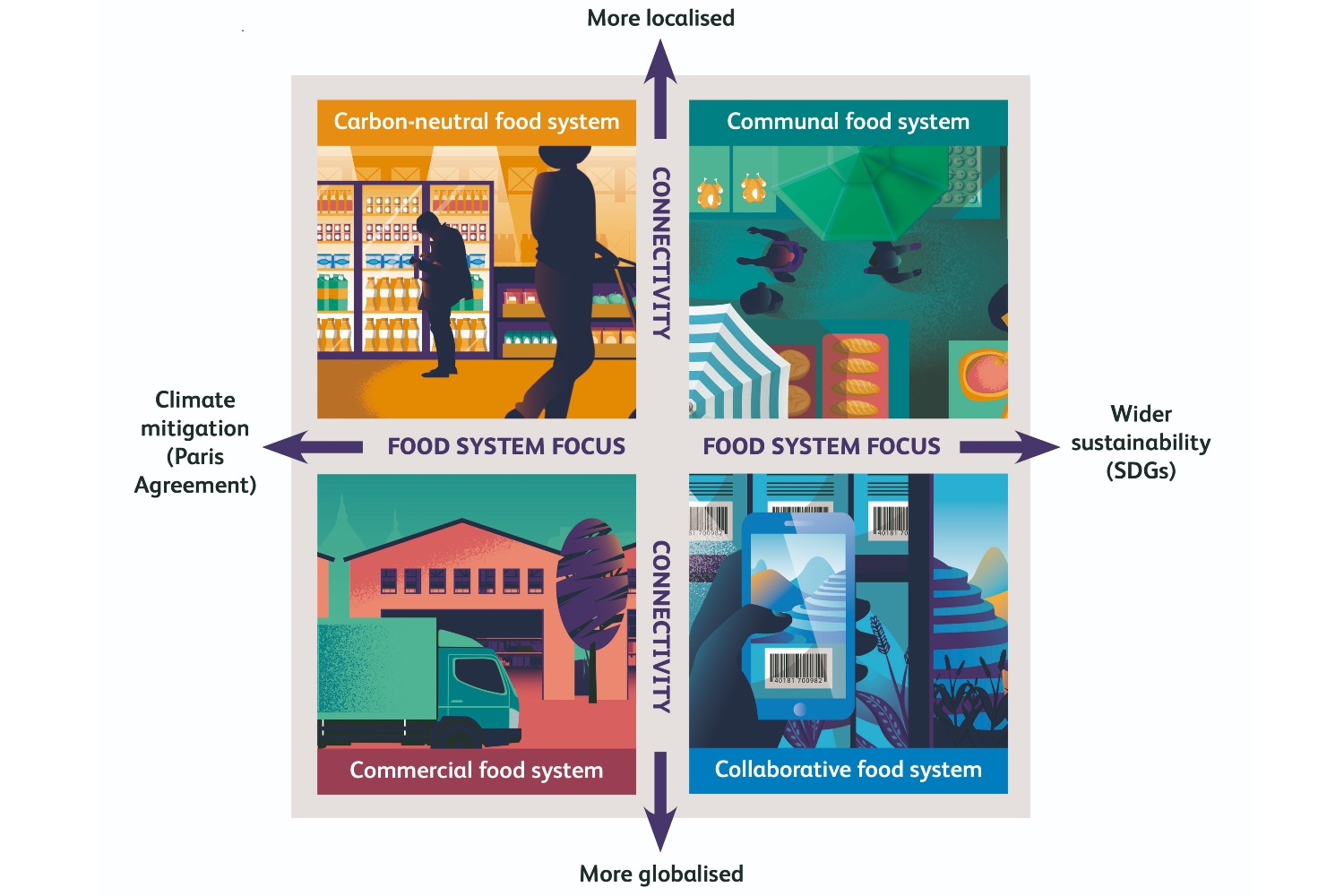A scenarios exercise run by UKRI’s Global Food Security (GFS) programme will provide policy-makers with food for thought over the coming years.
The findings are published today in:
- Nature Food: Scenarios for transforming the UK food system to meet global agreements, doi:10.1038/s43016-021-00257-1 (2021)
- GFS report: The role of the UK food system in meeting global agreements: potential scenarios (UKRI, 2021).
The discussion document examines four potential scenarios. The scenarios could influence how the UK’s food system engages with the challenge of climate change and how the country can meet its commitments to the world.
The landmark global agreements, the Paris Agreement and the UN Sustainable Development Goals (SDGs), have been key to shaping the current thinking on how we deal with the climate crisis.
Scenarios exercise
The GFS programme conducted a scenarios exercise with experts from across:
- research
- industry
- government
- civil society.
Recognising that change begins locally, they explored how the UK food system could be transformed to help meet these global agreements.
Four scenarios were developed based on the selection of two critical uncertainties that are expected to drive unforeseeable changes to the UK food system in the coming years:
- Will the UK food system be more localised or more globalised by 2050?
- What would the UK food system look like if it were transformed to focus on climate mitigation (like the Paris Agreement) or wider metrics of sustainability (like the SDGs)?
Transforming the UK food system
The report’s contributors explored what the UK food system might look like in the year 2050 if it was transformed to meet the UK’s climate mitigation and wider sustainability targets.
The four scenarios were set in futures where the food system is more globalised or more localised than it was in 2020.
Professor Tim Benton, Research Director in Emerging Risks at Chatham House said:
Decision makers implicitly often assume that next year will be like last year and so on into the future, and so plan ahead assuming the world will be like today.
In a very fast-changing world, this thinking applies even less than normal. Hence, this exercise looked ahead and developed plausible scenarios based on a world where lifestyles change, as does the geopolitics and reliability of trade.
How would such a future world change what we think we should invest in today to ensure our food supply in the decades ahead?
Four scenarios
The scenarios envisaged a spread of circumstances and futures:
The carbon-neutral food system
This scenario is more localised and focused on climate mitigation.
It describes a low emission future where domestic food production is boosted by the UK’s world-leading, ultra-efficient, low-carbon technology.
Food imports are reduced, making the UK less vulnerable to global food shocks and decreasing the impacts of the UK diet in other countries.
However, the mechanisation of food production and manufacturing has increased unemployment and exacerbated economic inequality.
Food prices have risen, and nutritional deficiencies and food bank usage are commonplace.
Mega farms producing food and energy dominate the countryside, leaving little space for wildlife and recreation.
The communal food system
This scenario describes a food system with a focus on wider sustainability.
The local-production-for-local-consumption ethos reigns, and the UK’s wealth and land have been redistributed amongst the population to reduce inequalities.
Local markets are at the heart of society, reviving the UK’s forgotten foods, seasonal eating and creative ways to use food excess.
The loss of productivity from comparative-advantage and trade, coupled with the need to diversify production and reduce the scale of farming, has increased food prices.
However, public policy is designed to make nutritious, climate-friendly food accessible to everyone.
While younger generations have developed strong food ethics, some of the older generation remain nostalgic for the abundance of cheap, unsustainable foods they grew up with.
This causes generational tension, particularly when domestic climate events disrupt the UK food system.
The commercial food system
This scenario is more globalised and low carbon.
It features a food system where the UK’s agricultural land has been replaced with plantation forests and renewable energy farms to meet national climate mitigation targets.
The UK is largely dependent on food imports, with only a handful of commercially run, agricultural farms remaining.
To protect the UK from global food shocks, supermarkets have shifted from just-in-time supply chains to maintaining huge stockpiles of long-life, fortified ready-meals.
Carbon pricing was central to achieving this food system, but a lack of support for rural communities and the poorest in society has deepened inequality and mental health problems.
High-emission foods such as red meat, dairy and rice are inaccessible for most people.
The collaborative food system
In this scenario, global governance and trade arrangements determine which foods are grown in which parts of the world to maximise yields and improve sustainability.
The UK’s primary export is red meat, with a world-class livestock system that emits minimal greenhouse gases while supporting biodiversity and reforestation.
However, red meat is now a luxury product, so the UK population eats mostly plant-based protein with some white meat.
This shift has helped reduce diet-related diseases and creates space for wildlife to thrive.
Technology enabled a low-carbon and fully transparent global food system, with supply chains managed through co-operative structures.
Citizen assemblies now inform UK food system policy.
However, slow uptake and engagement has allowed special interest groups to capture these platforms to sow doubt over the sustainability agenda.

Diagram showing four possible future UK food systems (credit: GFS). If you would like an accessible version please contact: maia.elliott@foodsecurity.ac.uk
Analysis reveals commonalities
An analysis of the hypothetical scenarios revealed several commonalities, such as:
- the inevitable rise of food prices (driven by climate change, the integration of novel technologies or internalising the external costs of food)
- the shift towards less land-intensive diets
- the win-win of eliminating food waste.
Differences across the scenarios were also informative, revealing the importance of considering wider sustainability (for example biodiversity and equity) in future climate mitigation strategies.
Key messages
The scenario analysis produced the following key messages:
- meeting global agreements on climate mitigation and sustainable development requires the radical transformation of the current food system
- future food systems must deliver against wider metrics of sustainability alongside ambitious climate mitigation
- transforming the food system to meet global agreements requires the development and implementation of a range of systems approaches and systemic technologies
- strategies to meet global agreements will vary greatly depending on a country’s reliance on global trade
- radical action must be taken today to ensure future food security.
Watch video: What will our food system look like in 2050?
Video credit: GFS programme
An autogenerated transcript of the video is available on YouTube.
Top image: Credit: StockSnap on Pixabay

